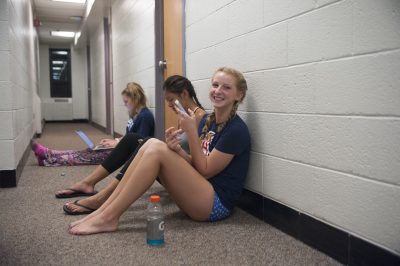Goal 5
Pursue IT solutions that can best be provided centrally and deliver them securely, efficiently, and robustly at scale.
Expansion of Capabilities
Microsoft 365 and all of its Office applications are widely used by faculty, staff, and students. We made updates to licensing and decisions about services that support full use of the tools available within the software suite.
Upgraded the Microsoft Enterprise License
ITS negotiates an annual Microsoft enterprise license on behalf of UConn that allows our community to install Windows and Office products on university-owned and personal devices. This year, we upgraded to a new education plan (Microsoft 365 A5). It includes elements that we had previously purchased separately, making it a more cost-effective selection, and provides enhanced security, larger mailbox size and access to new applications.
University-Wide Transition from Skype to Microsoft Teams
Microsoft announced plans to formally retire Skype in lieu of the more feature-rich Teams. To prepare for this change in advance, ITS transitioned the University to a Teams-only environment. Teams is formally integrated into the Microsoft 365 environment, giving our community access to more messaging, conferencing, and document sharing capabilities. To support the transition, ITS arranged for training sessions on Teams and developed our collection of support articles. We executed the change in August of 2021.
Microsoft Outlook Modern Authentication
The University was using basic authentication on Microsoft Outlook, and we transitioned the community to the more secure modern authentication in spring 2021.
Network Upgrades
ITS has completed the second year of the Wired Access Layer Refresh (WALR) project. The purpose of this multi-year project is to update networking for all campuses and bring the whole University to a contemporary standard. Upgrades include installation of new equipment, selective closet or room construction, and replacement of outdated cabling where needed.
The pandemic altered University operations, and new safety protocols limited our access to buildings in the first half of the fiscal year. Intrusive cable work in residence halls had to be deferred. While this meant that we could not improve the raw underlying bandwidth, we were still able to prioritize the installation of new equipment and improve overall wireless coverage for the start of the Fall 2020 semester. When safety protocols relaxed, ITS resumed previously deferred cabling for residence halls and completed installation of network equipment in remaining residence halls. We also substantially upgraded eight academic buildings and developed the designs for buildings at the Law School and the campus at Avery Point.

ITS has updated the wireless service in all UConn residence halls and brought them all to a common standard. You can track the status of this multi-year project to find out when a building is being updated.
File Storage
ITS has been evaluating and implementing strategies for safe, secure, and sustainable file storage. We implemented file archiving on the departmental file storage (Q: drive) and research drives (R: drive) this year. Files on these drives that have not been accessed or modified for a minimum of six months are moved to from faster, more expensive primary storage optimized for immediate access to slower, less expensive secondary storage designed for long-term file retention. With this approach, our community retains access to all their files, and ITS can better manage space concerns on primary storage.
High Availability Strategy: Disaster Recovery Testing
ITS annually tests the campus emergency disaster recovery (DR) plan to validate our ability to restore and operate essential IT services from our remote site in Groton. In previous years, we would practice failing over and then restoring the test environments of IT services. This year, we more closely simulated a DR situation and response by moving the following tier 1 production environments to Groton and then back to Storrs: Student Administration, Kuali Financials, Aurora (WordPress Service), and NetID. The testing was completed in June and provided us with valuable insight.
Enterprise Security Update
The data center houses servers and applications for ITS as well as other university customers. The network firewall protecting and monitoring traffic for these services will be end-of-life in September. ITS has migrated servers and applications hosted in the data center off of the old firewall onto the new one. In conjunction with the migration, we are adjusting firewall rules in an effort to improve our overall security posture.